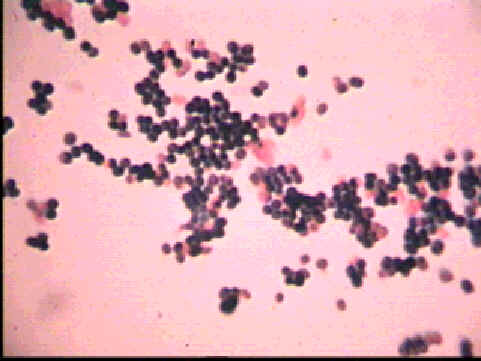| Technique | GRAM STAIN 09/02/01 | |||||||||||||||||||||||||||||||||||||||||||||||||||||||||||||||||||||
| Principle | The reaction to the Gram stain is a
stable characteristic of a bacterium. Cells that can resist decolorization with ethanol or acetone are Gram positive. Decolorized cells are Gram negative and must be visualized by a counterstain such as saffranine or Bismarck brown |
|||||||||||||||||||||||||||||||||||||||||||||||||||||||||||||||||||||
| Cautions | Although the most common stain in
microbiology, the Gram Stain is performed incorrectly
about 40% of the time A positive test is more significant
than a negative one as a Gram negative reaction may be
false due to Use positive and negative controls to detect the last two problems. Examine young
cultures before the end of the logrithmic growth phase, The bacteria should be completely free of all deposits od dye particles Some organisms have granules that resist decolourization |
|||||||||||||||||||||||||||||||||||||||||||||||||||||||||||||||||||||
| Method | 1 Prepare a smear 2: Heat fix 3: Flood with crystal violet solution 4: Leave for 1 min 5: Rinse briefly with tap water (not more than 2 sec) 6: Drain off the excess water 7: Apply the iodine solution of 1 minute 8: Rinse with tap water 9: Rinse with Decolourizerl until the solvent on the slide is colourless 10: Counterstain with safranine for 10 to 60 seconds. 11: Rinse with water, 12: Blot dry 13: Examine under the microscope. |
|||||||||||||||||||||||||||||||||||||||||||||||||||||||||||||||||||||
| Results | Gram positive organisms will appear
blue or purple Gram-negative organisms will appear red. |
|||||||||||||||||||||||||||||||||||||||||||||||||||||||||||||||||||||
| Positive control |
|
|||||||||||||||||||||||||||||||||||||||||||||||||||||||||||||||||||||
| Negative control | Escherichia coli (ATCC 11229) Transfer cultures daily on Trypticase soy agar slants. Make new transfers before using the cultures as controls | |||||||||||||||||||||||||||||||||||||||||||||||||||||||||||||||||||||
| Reagents |
|
|||||||||||||||||||||||||||||||||||||||||||||||||||||||||||||||||||||
| Reference | Manual of Clinical
Microbiology 1985 E. H. Lennette, A. Balows, W.J. Hausler
Jr, H. J. Shadomy American Society for Microbiology
Washington DC Manual of Microbiological Methods by the Society of Americam Bacteriologists 1957 McGraw Hill New York Hucker, G. J., and H.J. Conn 1923 Methods of Gram
Staining. N.Y. State Agr Expt Sta Tech Bull 129 |
|||||||||||||||||||||||||||||||||||||||||||||||||||||||||||||||||||||
